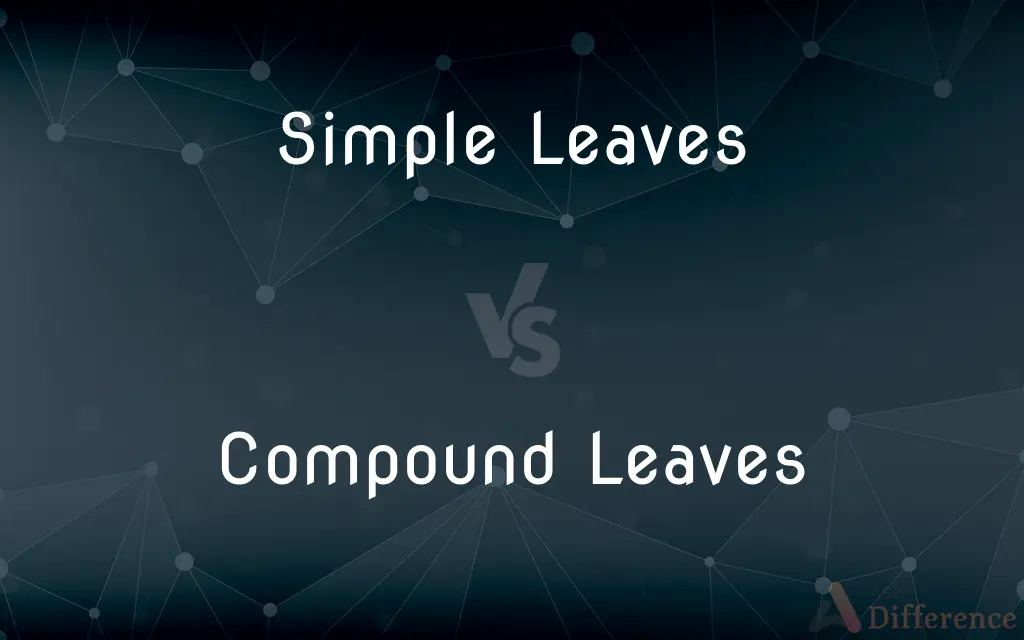Simple Leaves vs. Compound Leaves — What's the Difference?
Edited by Tayyaba Rehman — By Fiza Rafique — Published on January 5, 2024
Simple leaves have a single, undivided blade, while compound leaves are divided into multiple leaflets.

Difference Between Simple Leaves and Compound Leaves
Table of Contents
ADVERTISEMENT
Key Differences
Simple leaves are characterized by having a single leaf blade with a bud at the base. They have a uniform appearance, and their edges can be smooth or serrated. The leaf is attached to the stem by a petiole, and there are no further subdivisions in the blade itself.
Compound leaves consist of multiple leaflets joined to a single stem. Unlike simple leaves, there's no bud at the base of the leaflets. The leaflets can be arranged in various ways, such as pinnately, with leaflets along both sides of an axis, or palmately, with all leaflets attached at a common point.
The identification of simple leaves is typically easier, as they present as a single unit without subdivisions. Their structure can be quite varied in shape and edge configuration, ranging from round to lanceolate, with entire or lobed margins.
In contrast, compound leaves can be mistaken for multiple leaves, but the key distinguishing feature is that true leaves will have buds at their base. Compound leaves can offer advantages such as reduced wind resistance or damage from herbivory by presenting smaller individual leaflets.
To sum up, simple leaves and compound leaves can be differentiated by their structure and the presence or absence of a bud at the base. Both types serve the primary function of photosynthesis but differ in form and potentially in their adaptability to environmental conditions.
ADVERTISEMENT
Comparison Chart
Leaf Blade
One single, undivided blade.
Divided into multiple leaflets.
Arrangement of Leaflets
No leaflets, just one blade.
Leaflets arranged pinnately or palmately.
Bud Presence
Bud present at the base of the leaf stalk.
No bud at the base of the leaflets.
Complexity
Less complex structure.
More complex structure.
Adaptations
May vary widely in shape and size.
May reduce wind resistance or damage.
Compare with Definitions
Simple Leaves
Simple leaves feature a singular, intact leaf blade.
The oak tree's simple leaves turned a brilliant red in autumn.
Compound Leaves
Compound leaves are comprised of multiple, distinct leaflets.
The compound leaves of the rose bush were lush and green.
Simple Leaves
Simple leaves may have various edge designs, like serrated or smooth.
Maple trees are known for their simple leaves with distinctive lobes.
Compound Leaves
Compound leaves can be more efficient in self-shedding of water.
The pea plant's compound leaves quickly repelled water droplets.
Simple Leaves
The anatomy of simple leaves does not include separate leaflets.
The cherry tree's simple leaves had finely toothed margins.
Compound Leaves
Compound leaves do not have buds at the base of their leaflets.
Each leaflet on the compound leaves of the locust tree fluttered independently.
Simple Leaves
Each simple leaf is connected to the stem by a single petiole.
Simple leaves fluttered gently on the aspen's branches.
Compound Leaves
A compound leaf's leaflets are attached to a central rachis.
The fern's compound leaves spread out like a fan.
Simple Leaves
Simple leaves exhibit a range of shapes from oval to linear.
The simple leaves of the willow tree are narrow and elongated.
Compound Leaves
The leaflets on compound leaves may be arranged in various configurations.
The horse chestnut tree displayed its compound leaves with a palmate arrangement.
Common Curiosities
How are compound leaves structured?
They are divided into multiple leaflets.
Do all compound leaves look the same?
No, they can vary in leaflet arrangement and number.
What defines a simple leaf?
A leaf with a single, undivided blade.
Where is the bud located in simple leaves?
At the base of the petiole.
Can you name a plant with compound leaves?
The honey locust tree has compound leaves.
Do simple leaves have a main vein?
Yes, they often have a central main vein.
What's an example of a tree with simple leaves?
An example is the magnolia tree.
Are buds present on compound leaf leaflets?
No, buds are not present on the leaflets.
How do compound leaves aid in water shedding?
Their structure allows water to run off more easily.
Can simple leaves have lobed edges?
Yes, simple leaves can have lobed or smooth edges.
What advantage do compound leaves offer?
They can reduce wind resistance and damage.
Are simple leaves always smaller than compound leaves?
Not necessarily; size varies widely.
Can simple leaves be part of a compound structure?
No, simple leaves are not divided into leaflets.
What differentiates the leaflets of a compound leaf from individual leaves?
Leaflets of a compound leaf lack individual buds.
Do compound leaves change the way plants photosynthesize?
They don't change the process but may affect light capture efficiency.
Share Your Discovery

Previous Comparison
Private in C++ vs. Protected in C++
Next Comparison
Adzuki Beans vs. Red BeansAuthor Spotlight
Written by
Fiza RafiqueFiza Rafique is a skilled content writer at AskDifference.com, where she meticulously refines and enhances written pieces. Drawing from her vast editorial expertise, Fiza ensures clarity, accuracy, and precision in every article. Passionate about language, she continually seeks to elevate the quality of content for readers worldwide.
Edited by
Tayyaba RehmanTayyaba Rehman is a distinguished writer, currently serving as a primary contributor to askdifference.com. As a researcher in semantics and etymology, Tayyaba's passion for the complexity of languages and their distinctions has found a perfect home on the platform. Tayyaba delves into the intricacies of language, distinguishing between commonly confused words and phrases, thereby providing clarity for readers worldwide.
















































